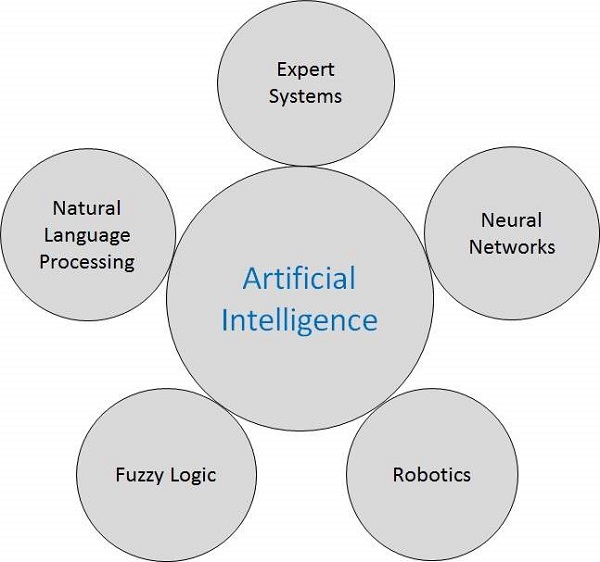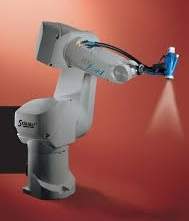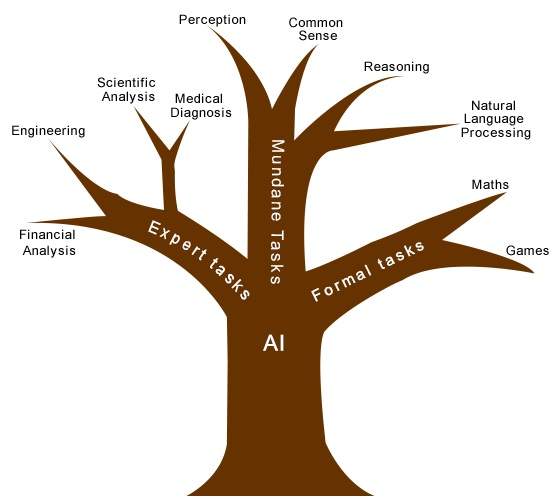
- Artificial Intelligence Tutorial
- AI - Home
- AI - Overview
- AI - Intelligent Systems
- AI - Research Areas
- AI - Agents and Environments
- AI - Popular Search Algorithms
- AI - Fuzzy Logic Systems
- AI - Natural Language Processing
- AI - Expert Systems
- AI - Robotics
- AI - Neural Networks
- AI - Issues
- AI - Terminology
- Artificial Intelligence Resources
- Artificial Intelligence - Quick Guide
- AI - Useful Resources
- Artificial Intelligence - Discussion
Artificial Intelligence - Research Areas
The domain of artificial intelligence is huge in breadth and width. While proceeding, we consider the broadly common and prospering research areas in the domain of AI −

Speech and Voice Recognition
These both terms are common in robotics, expert systems and natural language processing. Though these terms are used interchangeably, their objectives are different.
| Speech Recognition | Voice Recognition |
|---|---|
| The speech recognition aims at understanding and comprehending WHAT was spoken. | The objective of voice recognition is to recognize WHO is speaking. |
| It is used in hand-free computing, map, or menu navigation. | It is used to identify a person by analysing its tone, voice pitch, and accent, etc. |
| Machine does not need training for Speech Recognition as it is not speaker dependent. | This recognition system needs training as it is person oriented. |
| Speaker independent Speech Recognition systems are difficult to develop. | Speaker dependent Speech Recognition systems are comparatively easy to develop. |
Working of Speech and Voice Recognition Systems
The user input spoken at a microphone goes to sound card of the system. The converter turns the analog signal into equivalent digital signal for the speech processing. The database is used to compare the sound patterns to recognize the words. Finally, a reverse feedback is given to the database.
This source-language text becomes input to the Translation Engine, which converts it to the target language text. They are supported with interactive GUI, large database of vocabulary, etc.
Real Life Applications of Research Areas
There is a large array of applications where AI is serving common people in their day-to-day lives −
| Sr.No. | Research Areas | Real Life Application |
|---|---|---|
| 1 | Expert Systems Examples − Flight-tracking systems, Clinical systems. |
 |
| 2 | Natural Language Processing Examples: Google Now feature, speech recognition, Automatic voice output. |
 |
| 3 | Neural Networks Examples − Pattern recognition systems such as face recognition, character recognition, handwriting recognition. |
 |
| 4 | Robotics Examples − Industrial robots for moving, spraying, painting, precision checking, drilling, cleaning, coating, carving, etc. |
 |
| 5 | Fuzzy Logic Systems Examples − Consumer electronics, automobiles, etc. |
 |
Task Classification of AI
The domain of AI is classified into Formal tasks, Mundane tasks, and Expert tasks.

| Task Domains of Artificial Intelligence | ||
|---|---|---|
| Mundane (Ordinary) Tasks | Formal Tasks | Expert Tasks |
Perception
|
|
|
Natural Language Processing
|
Games
|
Scientific Analysis |
| Common Sense | Verification | Financial Analysis |
| Reasoning | Theorem Proving | Medical Diagnosis |
| Planing | Creativity | |
Robotics
|
||
Humans learn mundane (ordinary) tasks since their birth. They learn by perception, speaking, using language, and locomotives. They learn Formal Tasks and Expert Tasks later, in that order.
For humans, the mundane tasks are easiest to learn. The same was considered true before trying to implement mundane tasks in machines. Earlier, all work of AI was concentrated in the mundane task domain.
Later, it turned out that the machine requires more knowledge, complex knowledge representation, and complicated algorithms for handling mundane tasks. This is the reason why AI work is more prospering in the Expert Tasks domain now, as the expert task domain needs expert knowledge without common sense, which can be easier to represent and handle.